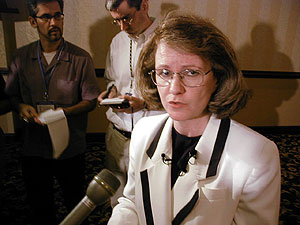|
Photos
More from MPR
Resources
Your Voice
|
List of underachieving schools shrinks to 144
August 14, 2003
State officials now say 144 schools are falling below performance goals, 115 fewer in their earlier calculations. The Minnesota Department of Education released its revised list of low achieving schools on Thursday after reviewing and correcting its data. Some school officials say the labeling of schools, accurate or not, is harmful.
Bloomington, Minn. — State education officials released a preliminary list last month that identified 259 of Minnesota's 1,800 schools as failing to meet performance goals. They measured elementary schools on test scores and test participation.
Middle schools and high schools had to meet attendance and graduation minimums. But after reviewing numbers and correcting errors, officials removed 93 schools from the list. Eighteen schools were removed as the result of changes in the way area learning centers are measured. Another four schools will have their status determined by the Bureau of Indian Affairs rather than the state.
Commissioner Cheri Pierson Yecke told members of the Minnesota School Boards Association she had wanted to handle the list revisions in a different way.
"We wanted to allow schools the time to review their data privately, so that corrections could be made. But after checking with the lawyers, we found that this would not be allowed," she said.
The so-called Adequate Yearly Progress list, or AYP, is a key accountability feature of the federal No Child Left Behind act. While all schools are measured, only those receiving federal funds for low income students can face penalties.
The state identified 119 schools this year as not making progress for the first time. The 10 schools identified as not making progress for two years must allow students to transfer to higher performing schools. After three years, 15 schools must now provide tutoring to struggling students.
The list is considered final for the coming school year, but Yecke says some schools could be added. She says the status of 200 schools is still pending.
"We are required by law to have an AYP status for every school in the state. We have some schools that are K-2 schools. They don't test. So, we have to go back and manually find out what is the feeder school that they feed into. And then the AYP status for the feeder school is given to the K-2 school," she said.
Under the No Child Left Behind law, schools must show progress in each of nine subgroups of students. Those categories include special education, English language learners, low income students and racial groups. The Minneapolis school district has 33 schools or programs listed. St. Paul had 17. The Bloomington school district has one school on the list.
The state identified Hillcrest Community School because the subgroup of low income students, those receiving free or reduced lunches, fell short on test scores. Superintendent Gary Prest says the entire school is being judged on the performance of just 22 students.
"For a school like that to be label as failing to make adequate yearly progress I think shows sort of the folly of the No Child Left Behind Act. The intent of the act is good. The implementation of the act creates situations such as we're seeing at Hillcrest Community School, which unfairly, and really I think inaccurately, type casts the school as failing to make progress," Prest said.
In the Northfield school district, Sibley Elementary School is no longer on the list. Superintendent Terry Tofte says the state wrongly identified Sibley on the preliminary list, claiming too few third graders participated in required tests. "One hundred percent of the students did take the test. The state simply miscounted the student population in that grade level by counting four students twice. It's a minor sort of a clerical error made on their end, but it ended up as the headline in our local newspaper that one of our fine elementary schools wasn't up to snuff," according to Tofte.
Tofte says correcting the error distracted his staff from other important work and was discouraging to the school.
Commissioner Yecke says the first year of implementing No Child Left Behind has been a big challenge. She announced the formation of a group of business, non-profit and higher-education organizations that will provide assistance to the 144 schools that remain on the list.
|
News Headlines
|
Related Subjects
|

